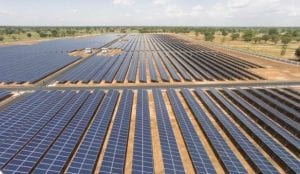Large scale solar contractor Sterling and Wilson has revealed that “torrential” rains and high labour costs have crimped its margins in Australia, its biggest market and where it is now also the biggest contractor of its type.
In a quarterly update to investors last month, Sterling and Wilson Renewable Energy revealed that its margins had been suppressed in the latest reporting period, mostly because of an increase in labor cost in Australia and the US, and because of extreme weather conditions in Australia.
“In the US, labor cost increased due to shortage of labor supply and in Australia (it was) labor cost, (and) site overheads increased due to the loss of productivity on account of extreme weather conditions,” it said.
None of this will be a surprise to anyone in the industry, which has also been buffeted by rising materials costs, and where rains have also flooded coal mines and swamped rail lines, but the fact that Sterling and Wilson is a listed company and is obliged to talk about such things offers rare insight.
The labor issue is a big one, and widespread. One developer told RenewEconomy recently that project directors were hard to find and had doubled their fees. Most prefer to stay at home and pick up their kids from school.
Sterling and Wilson has been working on some of the biggest solar projects in the country, including the biggest of all to date – the 400MW Western Downs solar farm owned by Neoen and being constructed in southern Queensland.
Western Downs is already partly finished and sending some power to the grid, although Neoen admitted last month that it had a problem over the timing of solar module deliveries, although it expected this to be resolved by year end.
Sterling and Wilson said costs of solar modules, which make up around 55 to 60 per cent of the cost of a solar project, had increased around 40 per cent from January, 2021, to March 2022, driven by higher commodity prices primarily on account of silicon and supply chain issues such as shortage of shipping containers.
It noted that steel contributes 5 to 10 per cent to the total cost of solar projects, and steel costs had risen by 25 per cent during the same period. Freight costs to India add 1.5 to 2 cents per watt, and in Australia and the US that can add close to 4 cents a watt, because of the extra distance.
It admitted that this had adversely impacted the anticipated returns (ROE) of solar power projects, and led to some developers postponing their plans to late this year or early next year. It noted that some price jumps and logistics costs caused by the Russia invasion of Ukraine had eased slightly.
Still, things were looking up because Sterling and Wilson is currently bidding for, and hopeful of winning, almost $1 billion of projects which it said “will help us to take the margins back to its normalised levels in the near future.”
Australia counts for the bulk of its revenue – just short of 60 per cent, well ahead of north America (21 per cent), India (15 per cent), and Africa and the Middle east (4 per cent).
“In Australia, the recent election has been a game changer in terms of policy support for renewable energy,” it said, noting the new Labor government’s target of 82 per cent renewables and a number of multi gigawatt project proposals such as Sun Cable and Asia Renewable Energy Hub.
It said the new Labor government will unlock renewables investment, upgrade the grid and bring federal policy more in line with the states and territories many of which have more ambitious climate goals.
“In Australia, where most of the projects are getting announced, we are the number one EPC in that market, and despite all the difficulties and headwinds which are faced by EPC market we are perhaps one of the players which have delivered even in the COVID period despite the commodity super cycle,” CEO Amit Jain said.
“We are on the course of delivering all our projects which have created a very, very strong brand for us in the market.” And Jain noted the deal with Indian industrial giant Reliance, which essentially underwrites its contracts, had given it financial strength, and likely a supply of solar modules in the future.
“So that places us favorably to work on those projects but as you know the projects are in initial stages. We are identifying, we have started discussion but exact how the things develop can be predicted in next 18 to 24 months period.”









